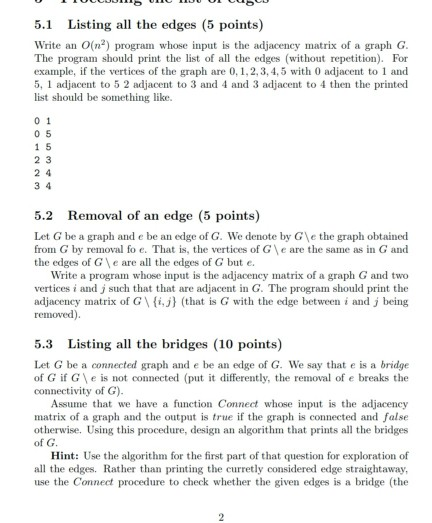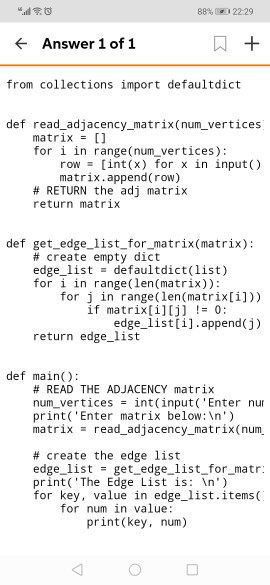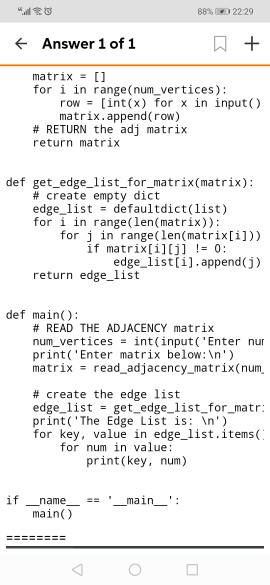Answered step by step
Verified Expert Solution
Question
1 Approved Answer
you answer this question before, I need more explanation, could you please provide me simpler answer (in python) ? I did not understand the solution

you answer this question before, I need more explanation, could you please provide me simpler answer (in python) ?
I did not understand the solution can you explain it to me please?


i did not understand this solution
5.1 Listing all the edges (5 points) Write an O(n) program whose input is the adjacency matrix of a graph G. The program should print the list of all the edges (without repetition). For example, if the vertices of the graph are 0, 1, 2, 3, 4, 5 with 0 adjacent to 1 and 5, 1 adjacent to 5 2 adjacent to 3 and 4 and 3 adjacent to 4 then the printed list should be something like. 0 1 05 15 23 24 34 5.2 Removal of an edge (5 points) Let G be a graph and e be an edge of G. We denote by G\c the graph obtained from G by removal fo e. That is, the vertices of G\e are the same as in G and the edges of G\e are all the edges of G but e. Write a program whose input is the adjacency matrix of a graph G and two vertices i and such that that are adjacent in G. The program should print the adjacency matrix of G\{1,j(that is G with the edge between i and being removed). 5.3 Listing all the bridges (10 points) Let G be a connected graph and e be an edge of G. We say that e is a bridge of Gif G\e is not connected put it differently, the removal of e breaks the connectivity of G). Assume that we have a function Connect whose input is the adjacency matrix of a graph and the output is true if the graph is connected and false otherwise. Using this procedure, design an algorithm that prints all the bridges of G. Hint: Use the algorithm for the first part of that question for exploration of all the edges. Rather than printing the curretly considered edge straightaway, use the Connect procedure to check whether the given edges is a bridge (the 88% 2229 + Answer 1 of 1 + from collections import defaultdict def read_adjacency_matrix(num_vertices matrix = [] for i in range(num_vertices): row = (int(x) for x in input matrix.append(row) # RETURN the adj matrix return matrix def get_edge_list_for_matrix(matrix): # create empty dict edge_list = defaultdict(list) for i in range(len(matrix)): for j in range(len(matrix[i])) if matrix[i][j] != 0: edge_list[i].append(j) return edge_list def main : # READ THE ADJACENCY matrix num_vertices = int(input('Enter nur print('Enter matrix below: ') matrix = read_adjacency_matrix(num # create the edge list edge_list = get_edge_list_for_matr: print('The Edge List is: ') for key, value in edge_list.items for num in value: print(key, num) 88% 2229 + Answer 1 of 1 + matrix = [] for i in range(num_vertices): row = (int(x) for x in input() matrix.append(row) # RETURN the adj matrix return matrix def get_edge_list_for_matrix(matrix): # create empty dict edge_list = defaultdict(list) for i in range(len(matrix)): for j in range(len(matrix[i])) if matrix[i][j] != 0 : edge_list[i].append()) return edge_list def main(): # READ THE ADJACENCY matrix num_vertices = int(input('Enter nur print('Enter matrix below: ') matrix = read_adjacency_matrix(num # create the edge list edge_list = get_edge_list_for_matr: print('The Edge List is: In') for key, value in edge_list.items for num in value: print(key, num) if == '__main__': _name__ main() ========Step by Step Solution
There are 3 Steps involved in it
Step: 1

Get Instant Access to Expert-Tailored Solutions
See step-by-step solutions with expert insights and AI powered tools for academic success
Step: 2

Step: 3

Ace Your Homework with AI
Get the answers you need in no time with our AI-driven, step-by-step assistance
Get Started


